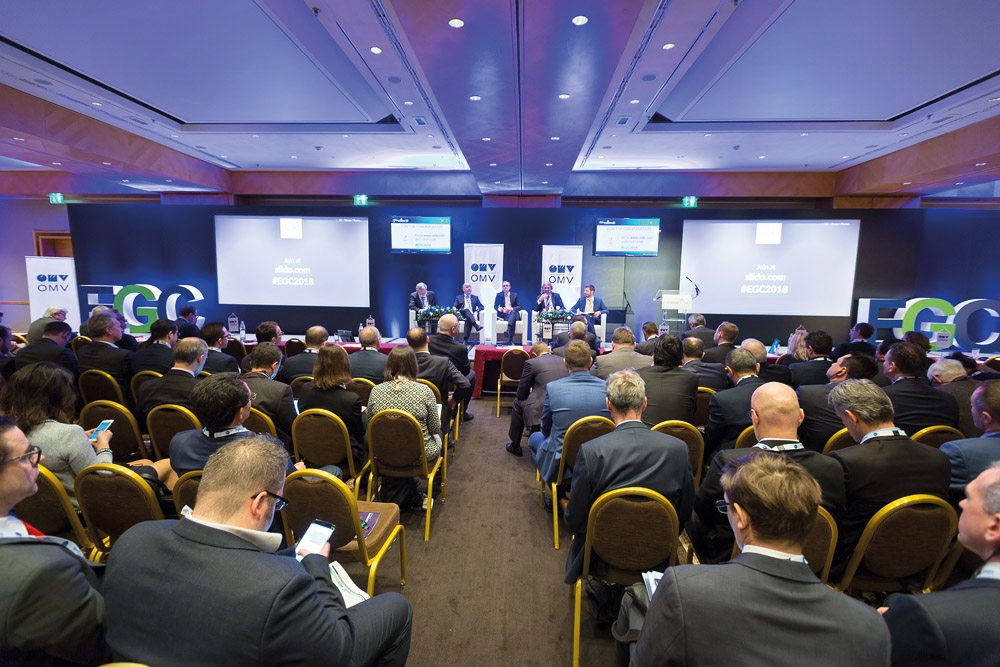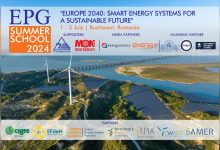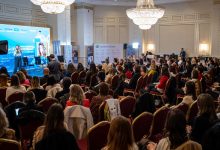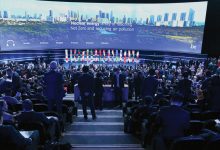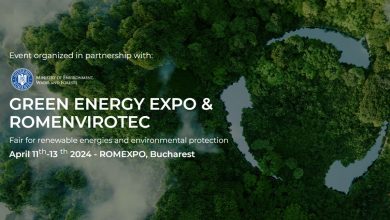European Gas Conference
Over 350 delegates gathered to discuss, debate and share insights on the current picture of gas in Central, Eastern and South Eastern Europe and how it connects with the rest of the continent.
Major themes
• The Big Gas Debate – This year debate was focused around Nord Stream 2.
• The results from the European Commission’s Quo Vadis Study what effects these results will have on the gas trading environment
• LNG – dealing with oversupply, how will this effect pricing and impact traders as well as exploring new LNG opportunities.
• Changing dynamics in the European market with Naftogaz recently winning a ruling against Gazprom and Lithuania being the first to receive LNG from the US in Europe.
Russia to bring security of gas supply to Europe
“Security of gas supply is crucial, and Gazprom brings it,” said OMV’s member of the executive board Manfred Leitner speaking at the European Gas Conference.
It means gas to heat houses, schools, hospitals and for European energy. The gas comes safely and at an affordable price,” Leitner said.
Leitner urged to stop being skeptical about Russia, given that the European gas production has been declining.
“If you look to Russia, they have the largest natural gas reserves in the world. In order to gain security of supply we have a chance to be directly linked to the biggest reserves of gas,” he added.
Manfred Leitner also mentioned that “obviously cyclical connection to these gas reserves is through the Nord Stream 2.”
The United States has been thwarting the project, as it wants to become a big player on the European gas market by shipping LNG to the continent. At the same time, America continues to import Russian LNG to satisfy the domestic demand.
Gazprom Chairman of the Board of Directors Viktor Zubkov said that the company’s share of the European gas market, where most of the revenue came from, grew last year to record levels of more than 35% compared to 33% in 2016. Gazprom’s gas exports to Europe and Turkey in 2017 increased by 8.1% to a record 193.9 billion cbm despite Europe’s efforts to reduce its dependence on Russian energy supplies.
In order to maintain its market share, Gazprom quietly negotiated price deals with large customers and succumbed to EU rules that he had previously ignored.
The Deputy Chairman of the Management Committee of Gazprom Alexander Medvedev explained at the conference that a stable demand for Russian gas in Europe would help keep exports of Russian gas around current levels.
We believe that demand factors will support exports of around 190 billion cbm although climatic factors are obviously influenced,” Medvedev underlined, adding that exports of Russian gas to Europe in January fell only 3% on an annual basis despite the warm weather. “Europe will need additional imports of 50 billion cbm pf natural gas to 2025 and 75 billion cbm by 2035. I think these data are attractive enough to all stakeholders and investors in the gas industry,” highlighted Alexander Medvedev.
Moving the European Union to a fully electrified economy using only renewable electricity and no natural gas would be ‘profoundly wrong,’ stated the European Commission’s, Klaus-Dieter Borchardt.
“If you go to other European conferences, you will hear that the future is the electrification of all sectors and electricity to be all renewable,” Borchardt affirmed at the European Gas Conference in Vienna. “This is, in my view, profoundly wrong and a mistake,” he said.
European electricity trade body Eurelectric in December called on EU policymakers to promote switching to ‘clean’ electricity in heating, transport and industrial sectors as part of efforts to decarbonize the economy by 2050.
Eurelectric has not called for an all-renewable approach – nuclear is also low carbon – but environmental lobby groups have used the dramatic falls in renewable costs to argue that a high renewable electricity share is increasingly cost-effective.
Eurelectric has also called for EU policymakers to promote digitalizing the entire electricity value chain, to make smart grids a reality and encourage demand-side response.
Relying on a fully digitized power-only system would leave the EU tremendously vulnerable to cyber-attacks, Klaus-Dieter Borchardt affirmed. It would also be a mistake to leave the EU’s gas infrastructure, which has been built up over decades and is still being invested in today, empty, he added.
Borchardt agreed with Alexander Medvedev, who was also speaking at the conference, that “gas cannot and should not be a bridge fuel for renewables… Gas should have its own role to play.”
The commission official stated that the European Commission would be working this year on proposals for EU gas market regulation, and wanted to explore in particular the possibilities for synergies between the gas and power grids, and for developing renewable gases.
“We can use the gas grid as (one of the storage options) that we are still lacking in the power system,” for example by transforming excess wind into methane or hydrogen, he detailed. This power-to-gas technology is still at a very early stage. “If we really believe in this technology, we have to show it can be rolled out at an industrial level,” he sustains.
Azerbaijan gas to Europe by 2020
The Southern Gas Corridor project, which envisages transportation of Azerbaijani gas to Europe is expected to start up this summer, said Vitaliy Baylarbayov, Deputy Vice President for investments and marketing at Azerbaijan’s state oil company SOCAR.
After years of planning, the USD 40 billion Southern Gas Corridor (SGC) backed by the EU to ease its reliance on Russia is set to start up on time this summer as line fill began just ‘days ago’ in the TANAP pipeline across Turkey, he said addressing the European Gas Conference in Vienna.
“We can proudly say that the Southern Gas Corridor will be inaugurated in 2018 and in the summer of 2018 the gas will start going to the SGC first into Turkey and then in 2020 to Europe,” he noted.
On the upstream side, Baylarbayov said activity continues at the Shah Deniz Phase 2 offshore development, but the wells needed for production start-up have already been drilled.
SOCAR is already considering Phase 3 of development of Shah Deniz gas and condensate field, Vitaliy Baylarbayov stated.
However, a final investment decision on Shah Deniz 3 is not expected before 2025, he mentioned addressing the European Gas Conference in Vienna.
Under Phase 3, SOCAR would drill into the deeper layers of the Shah Deniz field. A discovery has already been made in the deeper layers, and although reserves have yet to be confirmed, there are signs that Phase 3 could produce more than the initially expected 5 billion cubic meters per year,” Baylarbayov added.
Further, he pointed out that the TANAP pipeline is more than 91 percent complete and the Trans-Adriatic Pipeline (TAP) is 65 percent built.
After delivering first gas from Azerbaijan, Georgia and Turkey this year, TANAP will ramp up deliveries to Turkey to the contracted 6 billion cubic meters per year by 2020, Baylarbayov underlined.
He noted that TAP will supply first gas to Greece in 2020, after which it will gradually ramp up deliveries to 10 billion cubic meters per year, including around 8.5 billion cubic meters per year for Italy, 1 billion cubic meters per year for Greece and 1 billion cubic meters per year for Bulgaria.
Bulgaria should receive gas via the Interconnector Greece-Bulgaria, which is expected to be built by 2020, he said, adding that to cover the supplies, production at Shah Deniz Phase 2 is expected to reach its 16 billion cubic meters per year peak by 2024-25, or maybe earlier.
OMV to grow in European natural gas market via new LNG import deals
New medium-term LNG contracts with global suppliers will help Austria’s OMV to grow its market share in the European gas market, complementing its domestic supply and Russian imports, an executive stated.
OMV’s head of LNG Supply, Andy Williamson, told at the European Gas Conference in Vienna the two deals the company signed with Cheniere Energy and Qatargas in December 2017 reflect OMV’s strategy to expand its presence in Europe’s gas market.
The new supply will come through the Gate terminal in the Netherlands, which has the capacity to handle 12 billion cubic meters per year (Bcm/y) of LNG. OMV is a founding shipper at Gate along with Dong Energy, Eneco, Uniper and Shell, and holds a booked capacity of 3 Bcm/y.
“We’re very keen to grow our stake in the European market with LNG supplies,” he said. “They are in no way a substitution of supplies,” Williamson affirmed, adding that Cheniere and Qatargas were both ‘reliable suppliers’ and leaders in global LNG markets.
In late December, OMV agreed with Qatargas for the supply of up to 1.1 million mt/year of LNG into the Gate terminal from 2019 under a five-year deal.
It was the second term agreement signed by OMV as it looked to better utilize its capacity at Gate.
OMV in early December 2017 said it had signed a term deal with US LNG producer Cheniere for the supply of LNG from the Sabine Pass terminal in the Gulf of Mexico.


